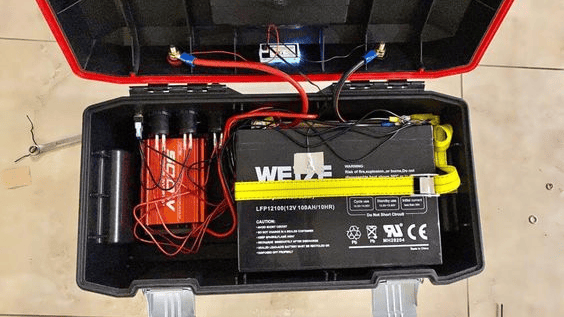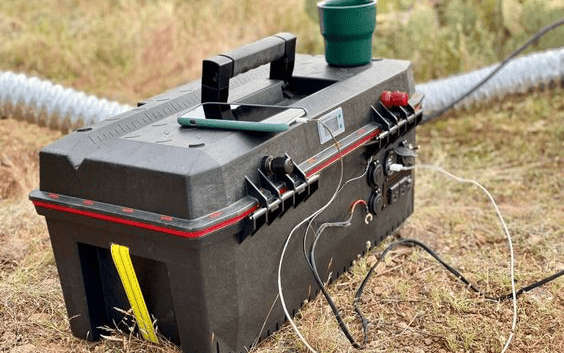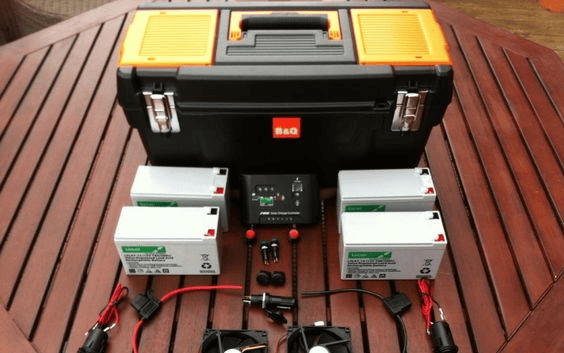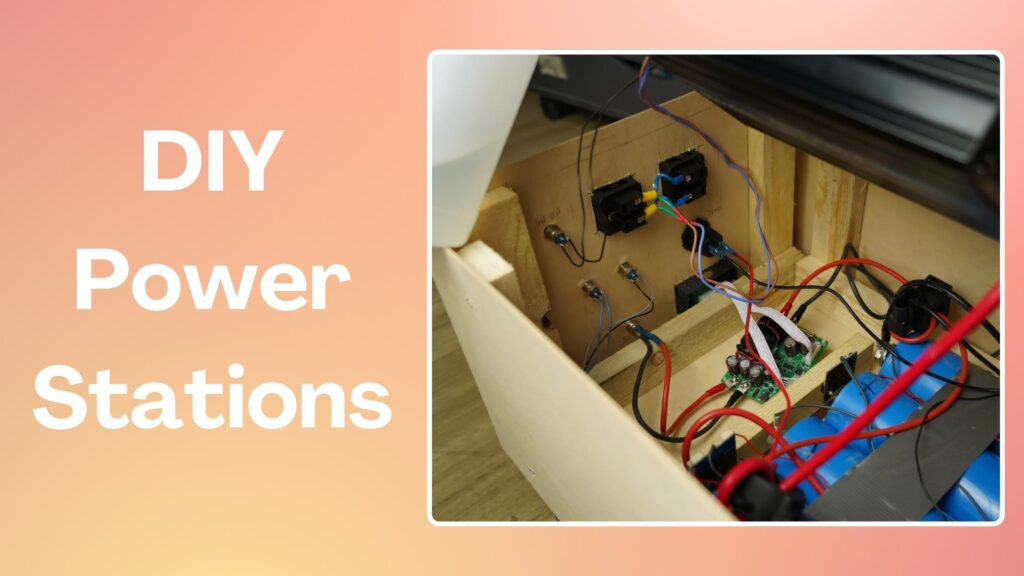Struggling with power on the go? Portable power stations bring energy to your fingertips wherever life takes you. Our guide dives into creating a custom DIY power station, tailored just for you and your projects.
Stay powered up – let’s get started!
Key Takeaways
- DIY power stations allow for complete customization, letting you tailor the battery size, inverter wattage, and solar panels to fit your specific energy needs.
- Portable power stations are cost – effective compared to traditional generators and can be safely used indoors without producing harmful fumes, making them suitable for a variety of settings.
- Regular inspection and maintenance of your DIY power station ensure its longevity and efficiency. Cleaning terminals, checking connections, and maintaining proper battery levels are key practices.
- With various charging methods available—solar panels, wall outlets, car chargers—you have flexibility in how you maintain your portable power station’s energy supply.
- Accessories such as expansion kits for solar capacity or battery modules can enhance the performance of your DIY power station setup according to your project requirements.
What is a DIY Power Station?
A DIY power station is a customizable energy solution that typically consists of a battery, inverter, and solar panel. Unlike portable power stations, DIY power stations allow for more flexibility in design and functionality.
Main components
Creating your own DIY power station puts control in your hands, allowing for a tailored approach to portable energy solutions. Building one involves combining several key components to store and manage electricity effectively.
- Battery: The heart of the power station, a high-capacity battery like a lithium power station unit stores the energy. You’ll want a battery big enough to meet your needs but also consider weight and portability.
- Inverter: This device converts stored DC power from the battery into AC power, making it usable for most appliances and tools. Choose an inverter with sufficient wattage rating to handle the load of connected devices.
- Charge Controller: Safeguards the battery by preventing overcharging and excessive discharge. It ensures your DIY portable power station’s longevity and efficiency.
- Solar Panels (optional): For renewable charging, solar panels can be integrated into your system. They provide sustainable power sources by converting sunlight into electrical energy that gets stored in the battery.
- Display Monitor or Gauge: Keeps track of remaining power levels and helps manage consumption. A clear display lets you monitor output and input without guesswork.
- Outlets and Ports: Depending on what you plan to connect, ensure there are enough USB ports, AC outlets, and possibly DC outputs as well.
Differences from portable power stations
Understanding the distinctions between DIY power stations and portable power stations is crucial for determining the best option for your energy needs. Here’s a comparative overview:
| Feature | DIY Power Station | Portable Power Station |
|---|---|---|
| Main Components | User-selected battery, inverter, charge controller, and optional solar panels. | Pre-assembled with an integrated battery, inverter, and charging system. |
| Customization | Highly customizable to meet specific project requirements. | Limited customization, as components are pre-selected by the manufacturer. |
| Cost | Typically more affordable upfront, cost depends on chosen components. | Cost varies by brand and capacity, may be cheaper for some users than building a DIY system. |
| Usability | Requires technical knowledge to build and maintain. | User-friendly, designed for immediate use with minimal setup. |
| Portability | Varies depending on the design and components used by the builder. | Designed to be portable, often with handles or wheels for easy transport. |
| Energy Independence | Can integrate various renewable energy sources. | Also integrates renewable energy, typically including solar charging capability. |
| Indoor Use | Safe for indoor use, similar to portable power stations. | Can be safely used indoors without emitting harmful fumes. |
| Size & Capacity | You control the size and capacity based on your project needs. | Comes in pre-determined sizes and capacities to cater to a range of scenarios. |
| Efficiency Enhancements | Can be expanded with additional solar panels and batteries. | May allow for expansion, but typically less flexible than DIY systems. |
| Fuel Cost | Electricity-powered, offering a cost-effective energy solution. | Electricity-powered, generally less expensive than fossil fuels. |
Choosing a power solution tailored to your specific needs is essential whether you’re an outdoor enthusiast or planning for emergencies. With this understanding of the differences between DIY power stations and portable power stations, let’s delve into the steps to build a DIY Power Station.
Benefits of a DIY Power Station

– A DIY power station is customizable for specific needs and more affordable than traditional generators, making it a great option for outdoor enthusiasts and those in need of portable power solutions.
Customizable for specific needs
DIY power stations are designed to be customizable, allowing you to tailor the system to meet your specific energy needs. You have the freedom to select the battery capacity, inverter size, and solar panel quantity that best suits your requirements.
This makes DIY power stations an ideal choice for anyone looking for a personalized and efficient power solution that can adapt to various projects and applications.
When considering a DIY power station, it’s important to assess your energy demands accurately so that you can customize the components accordingly. By understanding how each component contributes to the overall performance of your power station, you can create a tailored solution that aligns with your unique project needs and usage requirements.
More affordable than traditional generators
Portable power stations are a more cost-effective option compared to traditional generators. They generally have lower upfront costs and are easier to maintain, making them an attractive choice for those seeking an affordable energy solution.
Additionally, portable power stations can be used indoors safely, reducing the need for additional protection or safety measures when compared to traditional generators.
When considering energy solutions for your projects, it’s essential to evaluate the long-term savings and ease of use that portable power stations offer. Transitioning from traditional generators can not only save you money but also provide a more convenient and practical approach to powering your DIY projects.
Great for outdoor enthusiasts
Ideal for outdoor enthusiasts, portable power stations offer a reliable and convenient energy solution. With their lightweight and compact design, these power stations can easily be transported to remote locations or used during outdoor workshops, camping trips, or other off-grid activities.
These versatile devices are designed to integrate renewable energy sources such as solar panels, providing a sustainable power generation option that fosters energy independence. Additionally, the portability of these stations allows for easy mobility within an outdoor setting while ensuring a cost-effective and efficient power management system.
For those interested in purchasing energy solutions with a focus on outdoor activities and off-grid living scenarios where traditional grid connections may not be viable or available, portable power stations provide an excellent alternative.
Whether it’s powering tools at a remote work site or running essential appliances during recreational outings like camping and hiking trips, these DIY power solutions offer reliability and convenience for various applications.
How to Build a DIY Power Station

To build a DIY power station, you will need to carefully select the right battery, inverter, and solar panel for your specific needs. With the necessary materials and tools, you can follow a step-by-step construction process to create your own customized power solution.
Selection of battery, inverter and solar panel
When choosing components for your DIY power station, consider the following factors and options:
- Battery: Opt for a high-capacity lithium or lead-acid battery to provide long-lasting power storage. Lithium batteries offer higher energy density and longer lifespan, while lead-acid batteries are more affordable.
- Inverter: Select an inverter with sufficient power output to meet your energy needs. Look for pure sine wave inverters for smooth and reliable power delivery, suitable for sensitive electronics.
- Solar Panel: Determine the required wattage based on your energy consumption and available space. Monocrystalline panels are efficient in limited space, while polycrystalline panels are cost-effective for larger areas.
- Consider the compatibility of these components to ensure seamless integration and optimal performance in your DIY power station.
Necessary materials and tools
To build a DIY power station, you will need the following materials and tools:
- Battery: Choose a deep-cycle battery that suits your energy needs and integrates well with the power station kit.
- Inverter: Select a high-quality inverter that can convert the DC power from the battery into AC power for your devices.
- Solar Panel: Pick a durable solar panel with the appropriate wattage to charge your battery efficiently.
- Wiring and Connectors: Acquire suitable wiring and connectors to safely connect the battery, inverter, and solar panel.
- Battery Management System (BMS): Incorporate a BMS to monitor the battery’s health, prevent overcharging, and ensure long-term performance.
- Tools: Gather basic hand tools such as wrenches, screwdrivers, wire cutters, and crimping tools for assembly and installation.
Step-by-step construction process
To build a DIY power station, follow these steps:
- Choose a high – quality deep cycle battery with sufficient capacity for your energy needs, considering the available space and weight restrictions.
- Select an inverter with the appropriate wattage rating to handle the power load from your devices and appliances, ensuring compatibility with the battery voltage.
- Install a solar panel or panels on a sturdy mount, ensuring they receive maximum sunlight exposure throughout the day.
- Connect the solar panels to a charge controller to regulate the charging of the battery and prevent overcharging.
- Wire the battery to the inverter, following proper safety precautions and using insulated cables of suitable gauge for optimal performance.
- Test the system thoroughly to ensure all connections are secure and that it functions as expected.
- Monitor and maintain your DIY power station regularly to ensure its long – term reliability and efficiency.
Maintaining and Using a DIY Power Station

Regularly inspect your DIY power station, maintain the battery, and follow safety precautions to ensure efficient and safe usage. To learn more about maximizing the potential of your DIY power station, continue reading the full blog post.
Regular inspection
Regularly inspecting your DIY power station is crucial for ensuring its optimal performance and longevity. Here are some essential steps to follow:
- Check the battery connections for any signs of corrosion or loose connections.
- Inspect the solar panels for dirt, debris, or damage that may affect their efficiency.
- Monitor the inverter for any unusual sounds or overheating during operation.
- Ensure that all cables and wires are securely connected and free from damage.
- Test the overall system functionality by running a full charge – discharge cycle to gauge its performance.
- Keep an eye on the battery voltage levels to ensure they remain within the recommended range.
- Clean the exterior of the power station to prevent dust buildup and maintain its aesthetic appeal.
Battery maintenance
To keep your DIY power station working efficiently, regular battery maintenance is crucial:
- Clean the battery terminals and connections using a solution of baking soda and water to prevent corrosion.
- Inspect the battery for any signs of wear or damage and replace if necessary to avoid potential failure.
- Check the electrolyte levels regularly and top up with distilled water as needed to ensure optimal performance.
- Test the battery voltage to ensure it is within the recommended range for proper functioning.
- Keep the battery in a cool, dry place to prolong its lifespan and prevent overheating.
Safety precautions
To ensure the safe operation of your DIY power station, it is crucial to follow these essential safety precautions:
- Regularly check the condition of all components, including the battery, inverter, and solar panel, to identify any signs of wear or damage.
- Properly maintain the battery by keeping it clean and dry to prevent corrosion and ensure optimal performance.
- Adhere to recommended safety guidelines while handling and operating the power station to avoid electrical hazards.
- When using the DIY power station as a battery backup, ensure that it is positioned in a well – ventilated area to prevent overheating and maintain proper airflow.
- Familiarize yourself with the correct methods for charging the power station, ensuring that all connections are secure and free from damage.
- Select the appropriate power station size and capacity based on your specific energy needs to avoid overloading or underutilizing the system.
- Always use recommended accessories compatible with your DIY power station for optimal functionality and safety.
- Consider integrating multiple solar panels and batteries into your portable power station setup to enhance overall efficiency and energy storage capabilities.
- Understand how your portable power station operates and familiarize yourself with its charging procedures to maximize its performance within DIY projects.
How to use as a battery backup
When it comes to using your DIY power station as a battery backup, it’s essential to understand its capabilities and limitations. With a seamless transition from solar or grid power to stored battery energy during power outages, you can ensure uninterrupted electricity supply for essential devices.
It’s crucial to regularly monitor the battery level and charge it when necessary, ensuring that it’s readily available for use as a backup during emergencies.
You can also integrate your DIY power station with an automatic transfer switch (ATS) or inverter charger, allowing it to kick into action immediately when the primary power source fails.
Ways to charge
To charge your DIY power station, you can use various methods to keep it powered up efficiently and effectively. Here are some ways to charge your portable power station:
- Utilize solar power: Connect the power station to a compatible solar panel to harness energy from the sun.
- Plug into a standard wall outlet: Use an AC adapter to charge the power station from a conventional electrical socket.
- Employ a car charger: Take advantage of a DC input option to charge the power station from a vehicle’s cigarette lighter port.
- Utilize alternative charging methods: Consider using wind turbines or hydroelectric generators for environmentally-friendly charging options.
Choosing the right power station for your needs
Consider the size and capacity of the portable power station based on your specific energy requirements. Pairing it with multiple solar panels and batteries can enhance its efficiency, providing a cost-effective and sustainable energy solution for your DIY projects.
Understanding how a portable power station works, including the selection of battery, inverter, and solar panel, is essential for maximizing its potential benefits.
Evaluate the total wattage output and number of outlets to ensure that the portable power station can meet your needs during outdoor activities or as a reliable source of backup power at home.
Recommended accessories
To enhance the efficiency and functionality of your DIY power station, consider these recommended accessories:
- Solar Panel Expansion Kits: Expand your power station’s solar capacity to increase energy production and reduce reliance on grid power.
- Multi-Port DC Adapters: Enable simultaneous charging of multiple devices, maximizing the utility of your power station.
- Portable Power Station Cart: Easily transport heavy power stations to different locations for versatile use in various projects.
- Weatherproof Covers: Protect your power station from outdoor elements, ensuring durability and longevity in rugged environments.
- Mobile App Monitoring Systems: Access real-time data on energy consumption and battery status for optimal management of your power station.
- Battery Expansion Modules: Increase the storage capacity of your DIY power station by adding extra batteries, extending usage times during off-grid activities.
- MPPT Charge Controllers: Optimize the charging efficiency of solar panels, enhancing energy conversion and utilization within the power station system.
- LED Lighting Systems: Illuminate work areas or campsites using energy-efficient LED lights powered directly from your DIY power station setup.
- Car Charging Adapters: Utilize available vehicle power for emergency recharging or as an alternative charging source for extended off-grid periods.
- Customized Mounting Brackets: Securely install solar panels and accessories to ensure stability and maximize energy capture in diverse environmental conditions.
Conclusion
Consider the diverse benefits of integrating DIY power stations into your projects. Empower yourself by customizing a power solution tailored to your unique needs. Explore the affordability and convenience of portable power stations, making them an ideal choice for outdoor enthusiasts.
Ensure you select the right components and maintain your DIY power station for long-lasting, reliable performance. Choose renewable energy sources and optimize charging methods to achieve true energy independence.
FAQs
1. What is a DIY portable power station and how can I use it for my projects?
A DIY portable power station is a custom-built battery charging station that you can use to power your projects anywhere, especially if you’re off the grid or need electricity during camping.
2. Can I make a solar-powered portable power station on my own?
Yes, you can create your own DIY portable solar power station with the right tools and components like solar panels and batteries designed for life outdoors or in remote locations.
3. Is it possible to build a lithium-based DIY power solution?
Absolutely! You can assemble a DIY lithium portable power station using lithium battery technology for a lightweight, efficient, and powerful energy source for all your project needs.
4. Are there kits available to help me build my own portable power station?
Indeed there are! You’ll find various DIY portable power station kit options that include everything you need to put together your very own custom battery system.
5. How do these stations help when going camping or living off-grid?
DIY Portable Power Station for Camping provide reliable electricity without needing traditional sources; perfect when exploring nature or living away from city networks.

